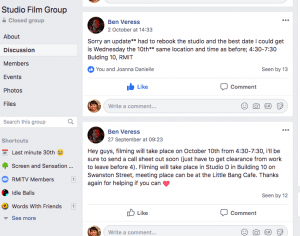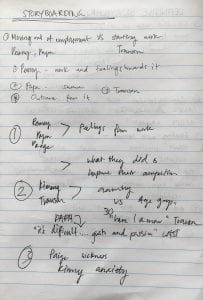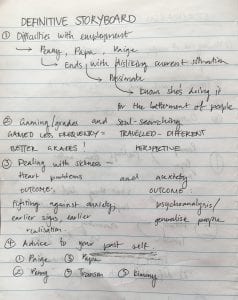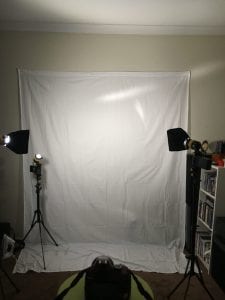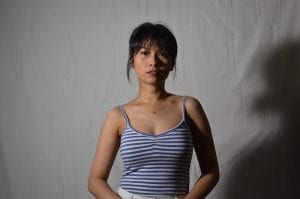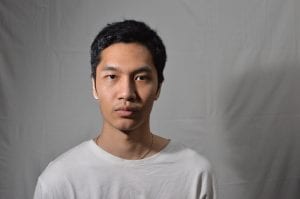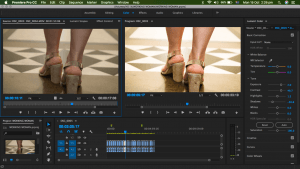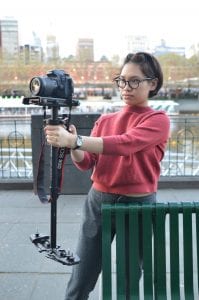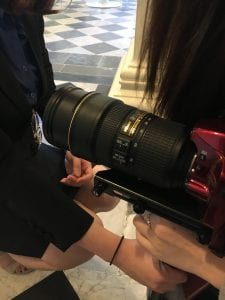In the second film project, I had the opportunity to work by myself or work with others. However, I thought to myself, why not do both? So after three productions (including myself), I made a lot of memories and gained a lot of experience from all these productions. They were all very different productions with Pavina going for the advertisement route, Ben hosting his own talk show and finally, mine being an interview.
Pavina’s assignment:
In these productions, I wasn’t deeply involved or invested in it as much as I was for my own, naturally. In Pavina’s project, I decided that I would help her out with cinematography as she expressed that she wanted to learn more about it and improve on it. With that in mind, we tried to make it flashy and “commercial-ly” as much as we could – a lot of advertisements aim to make the product and the model wearing the product stand out. During production, Pavina had also planned locations to showcase and make the shoes stand out even more. Melbourne is known for their structural architecture with the mix of traditional and modern buildings, along with the natural settings such as the gardens and parks.
I also believe there were bits of inspiration from our previous short film, “Missed Moments” – a silent film and a “landscape-y”, architectural type of short film. There were a lot of similarities between Pavina’s first film project and her second one – the music score was important for both films and crucial to setting the whole mood of the film. Her backstory also followed a similar path with Missed Moments, with Chinatown being the ending scene of both short films.
I also took part in the post-production process, only for the colour correcting and the stabilising stage. It was all left for Pavina to sequence the scenes but I had a general idea of how she was going to organise each and every scene. During the production, we made sure to film the transitions from one shoe to another, creating a stylised effect of switching from one scene to another. I believe these types of transitions makes it interesting for the viewers, especially since it is such a simple video with commercial aspects to it. Behind the editing are the emotional aspects that were directed by Pavina and performed by the actress and actor –emotions serve to organise perception and action to attain specific goals (Texeira, 2012) and through this commercial video, that was achieved not only by including what was supposed to be advertised (the shoes) but also the facial expressions of the actress.
Transition at 00:16, 00:46, 1:34 and 2:02
In this production, I tried to not overstep my boundaries as I was only helping out Pavina with her project – I felt like I took the lead with the previous film project but this time, I let Pavina figure how she wanted to shots to look but of course, I helped her out. All in all, it was all a very collaborative effort and I feel like Pavina and I work quite well together. I’m looking forward for more future projects with her!
Ben’s assignment:
This will fairly be short as I was only involved in the production process. I also had no idea what the content was going to be, except that it was going to be filmed in a studio setting.
Most of the communication was done on Facebook, and I’m proud of Ben for managing to set up a whole crew of talented folks, especially the talent, George Bush’s impersonator. Through all of my previous experiences in a studio, I applied all the knowledge I had to help out Ben with lighting and autocue. Autocue was a breeze but it was lighting that I struggled with for the most part. For the first time, I finally had the opportunity to physically move the lighting and playing around with the settings. Doing it all on my work has made me experience more and go through a learning curve that can only happen through practical work. All in all, I think I got the desired look that Ben was aiming for and I hope he is happy with the final shot:
I am more than happy to help out Ben in the future and also possibly collaborate with him on any future projects. He really takes on this “dark humor” persona really well and is something that should be explored thoroughly.
My own production:
RESEARCH FOCUS: Character development, drama and reality
During my pitch in the earlier weeks of the semester, I had expressed that I wanted to focus on more the dramatic and realistic aspects of life. Initially, I was not planning on having a production for myself and all on my own – I was planning to collaborate with Pavina once again but I thought that truly following my research focus was important to me and my development as an aspiring filmmaker.
I had expressed that I was interested in family issues from the examples that I showed but James had told me to reconsider whether it was cinematography or the content that I wanted to focus on. Eventually, I came with the conclusion that it was the content (drama, reality) that I was interested in. Having a simple production and shoot would have made it easier for me to truly focus on developing the theme of the whole film. I was inspired by this video to pursue this kind of content, where real-life issues are being discussed with minimal effort for cinematography and all that technical jazz.
You can clearly see the underlying drama that is about to unfold as you watch it throughout the ending of the video and that is exactly what I was aiming for.
As I was developing what the film was going to be about, I actually had a difficult time figuring that part out. With the little time I had, I knew that I could only rely on the resources I had around me and tha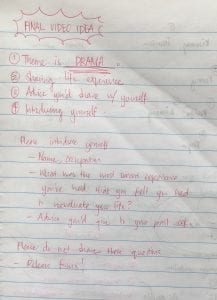 t was my family. I knew for sure that it was going to be an uncomfortable situation, especially with me asking questions that involved their personal lives. It’s not that I had no knowledge of what was happening with them but more so the fact that they were going to speak about it on camera with an audience. Despite all of those worries, I managed to finalise what it was going to be about.
t was my family. I knew for sure that it was going to be an uncomfortable situation, especially with me asking questions that involved their personal lives. It’s not that I had no knowledge of what was happening with them but more so the fact that they were going to speak about it on camera with an audience. Despite all of those worries, I managed to finalise what it was going to be about.
So yes, a lot of personal questions involved with a little backstory of themselves. It is important for the viewers to be engaged with the people on screen so I thought that if they talked about their occupation and the difficulties of it, it would add nice little touch to the overall short film.
The editing process was one of the most difficult and longest process that I have ever encountered. Storyboarding and editing different stories from the talents was difficult to coordinate but eventually I got there. Initially, I was planning to actually incorporate the questions in the video to guide the viewers. However, when I had my talk with James, he suggested that in order to make the video artistic, “make links and connection between the same topics”. It did make it hard at times to make links between what the talents were talking about. To make my editing job easier, I wrote it down:
I numbered what was the most relevant to each other in order to make the links and also broke it down to three parts as seen in the second photo. In comparison to my initial vision where it was going be organised by each question, I decided to make a whole story about it and turned out better and interesting all thanks to James’ suggestion.
James had also suggested that to get reinspired from the constant editing, colour-correcting it in the earlier stages could potentially help out with that. I had no plans to actual put a LUT on it and was simply just planning to adjust the exposure, contrast, etc. However, the LUT that I used put a much more dramatic effect on the whole video and added the right amount of shadows that I needed to slightly hide their face and highlight the key light (in this case, it would be the left side).
You can see that there is sort of a film effect to it, something I would refer to as an “indie film” look. The LUT and the content did compliment each other and only made the video more interesting to watch (at least I thought it did).
In terms of the music score, that is something that I am extremely proud of but also something that I struggled choosing. I didn’t really know what mood I was going for, other than the fact that it was drama. My most reliable source for music is Youtube’s audio library and naturally, I went through the dramatic, dark and inspirational genres for the music score. After a few tries and few trials and errors, I’m happy with the overall finished product. That is the, the look, the content, the music and basically the whole film itself.
The only negative thing I can say about this short film is that you are able to tell that it is a student film/low budget film. Because I didn’t focus too much on the technicality and the cinematography, it didn’t have the intended look that I wanted, much like in the video example that I provided above. However, I think all the other aspects compensated for the lack of budget I had for this student film.
My whole production has made me realise the artistic, technical and creative capabilities that I can reach and keep continuing to reach. I hope to make even better videos like this with better production value.
Academic Resources:


